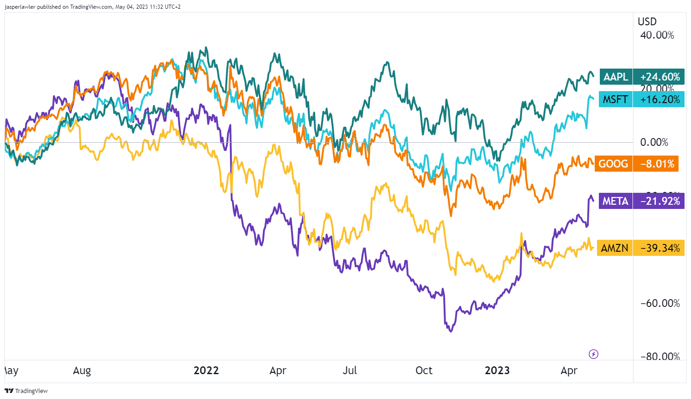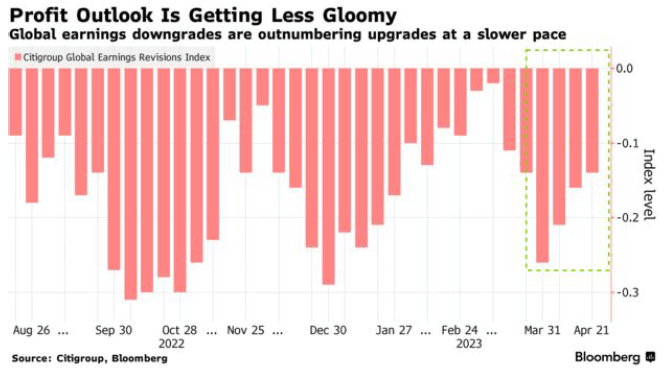Half of the S&P 500’s Top Ten firms reported earnings over the past month, and these tech heavyweights may be pointing toward a break in the global economic storm.
Despite recent headlines about slashed bottom lines, many of the biggest names in tech demonstrated remarkable innovation in realigning existing business models and infrastructure to adapt to new times despite effectively “growing up” amid the loosest monetary policy decade in history.
Furthermore, many of these firms’ reports point towards early signs of consumer-level economic reversals if you read between the lines. Booms and renewed interest in cyclical products mean customers might be budgeting beyond the bare minimum again, boding well for a broad recovery.
Still, new threats and entrants pose risks to the industry, leaving many investors and analysts wondering whether Big Tech will be as resilient as they have been since 2021.
Tech Today
Tech entered 2023 amid sweeping layoffs that continued in earnest throughout the first half of the year as more than 185,000 employee layoffs across (as of May 1st, 2023) already outpaces 2022’s net loss of 154,336 across 1,024 firms. With cuts of that magnitude and other news swirling around inflationary and lessened demand themes, many expected a lacklustre earnings season.
But that wasn’t the case!
It helps to think of the layoffs and other headline-worthy cost-cutting measures as lagging indicators. Having done as much as possible before taking drastic decisions, one of the last-line initiatives tends to be layoffs. So from an optimistic perspective, that the worst may be over.
Big Tech performance (2 years)

Source: TradingView / FlowBank
This earnings season bears that thesis out:
Microsoft (MSFT)
MSFT expanded its top-line growth and projections while trimmings its bottom line; 7% YoY revenue growth is a strong stability indicator and shows MSFT’s economic resiliency.
Amazon (AMZN)
AMZN’s web-side sector suffered as core clients cut costs of their own, but the company’s retail sales more than compensated for the losses as revenue from physical and online storefronts remained steady. Subscription service purchases also increased by 15%, which is particularly noteworthy as those types of service are often first cut when consumers close their wallets – meaning that subscription services may be a leading indicator for broad economic recovery.
Alphabet (GOOG)
YouTube continues struggling with social media heavyweight competitors, but improved search engine revenue combined with the firm’s ongoing investment in AI technology and talent proved positive news for investors.
Meta Platforms (META)
Meta proved surprisingly strong as Reels revenue beat many expectations, although the ongoing TikTok controversy may contribute more than any managerial or executive-driven genius. Still, Meta’s Facebook brand and peripheral properties are pervasive, and ad conversion rates remain strong as online shopping cement itself as the norm post-pandemic. And, like AMZN, strong digital ad conversions may be a leading indicator of consumer sentiment reversals.
The earnings, as usual, are leading the analyst ratings, where there are still more downgrades than upgrades, but the difference has lessened since March.
 Source: Citigroup / Bloomberg
Source: Citigroup / Bloomberg
Tech Tomorrow
Two of the largest tech firms, Apple (AAPL) and Nvidia (NVDA) have yet to report, but most analysts don’t expect a significant deviation from prevailing trends.
Apple is particularly sensitive to consumer budget cuts as their pervasive hardware is nevertheless pricy, and Nvidia is in a similar boat. Still, both show innovation in the face of macroeconomic shakiness as Apple pivots into commercial savings account opportunities and Nvidia expands AI opportunities.
That’s the short-term, though – what about the future?
All About AI
AI is another of 2023’s watchwords, as many armchair analysts predict the demise of many white-collar gigs at the hands of new robotic overlords! What’s notable enough for inclusion in this article is IBM CEO Arvind Krishna’s May 2nd announcement that he’s halting new hires for many back-office (non-client facing) roles like human resources and accounting on account of AI innovation.
In a press release, Krishna said he “could easily see 30% of that getting replaced by AI and automation over a five-year period.”
If big-name companies like IBM are floating the idea of AI replacement across their industry, the threat alone may prove a self-fulfilling prophecy. Sparked interest drives innovation and may ultimately create a reality in which (in Krishna’s words) AI is a firm’s driving force behind the bulk of clerical and administrative white-collar work.
Conclusion
The tech sector must remember the lessons it's learning today to be successful moving forward. We're unlikely to see debt as cheap as it has been since 2010. Runaway spending and bloated workforces might need to be a permanent thing of the past if these firms are to rebuild a stable economic foundation in the sector. The firms that most embrace AI will likely be the ones that can keep costs down and stay relevant.
Recent earnings proved that many firms are pulling ahead. Still, parallels between rabbits and hares are easy to envision – can these companies stay the course long enough to make lasting change and win the race, or will newer, more agile, and nimble companies beat out the (now lumbering?) giants of tech?




